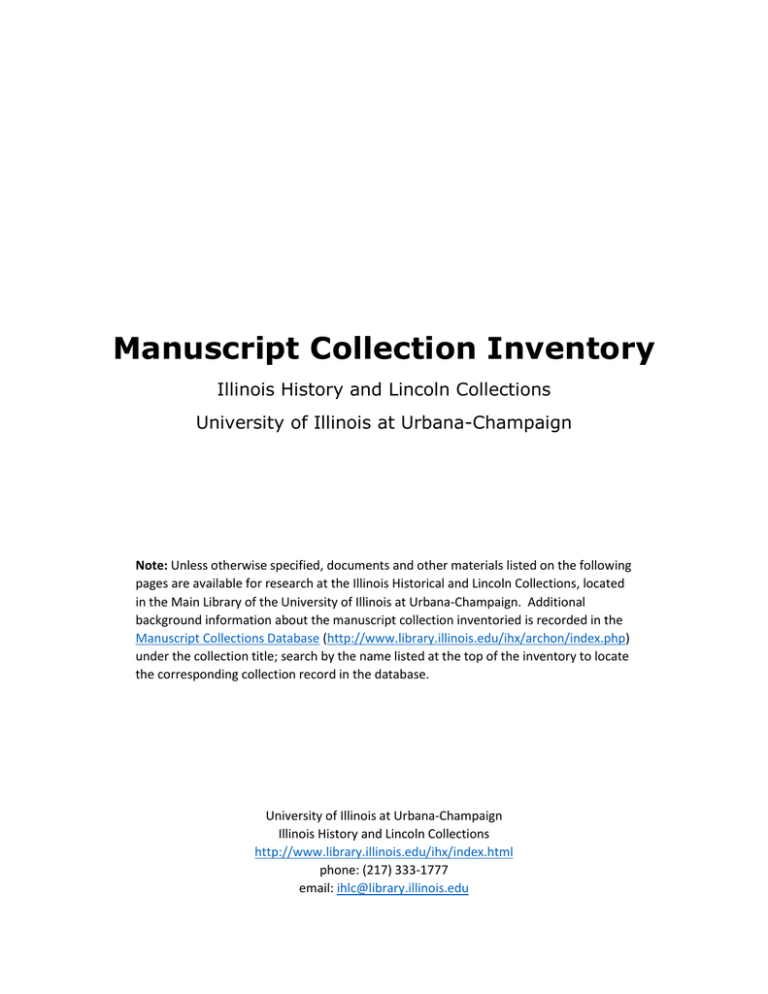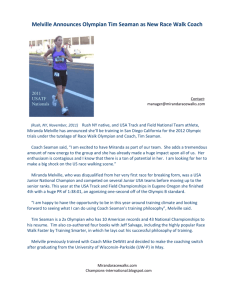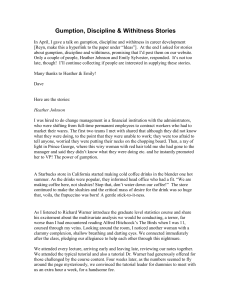Manuscript Collection Inventory Illinois History and Lincoln Collections
advertisement

Manuscript Collection Inventory Illinois History and Lincoln Collections University of Illinois at Urbana-Champaign Note: Unless otherwise specified, documents and other materials listed on the following pages are available for research at the Illinois Historical and Lincoln Collections, located in the Main Library of the University of Illinois at Urbana-Champaign. Additional background information about the manuscript collection inventoried is recorded in the Manuscript Collections Database (http://www.library.illinois.edu/ihx/archon/index.php) under the collection title; search by the name listed at the top of the inventory to locate the corresponding collection record in the database. University of Illinois at Urbana-Champaign Illinois History and Lincoln Collections http://www.library.illinois.edu/ihx/index.html phone: (217) 333-1777 email: ihlc@library.illinois.edu 1 Louis Livingston Seaman Collection, 1869-1932. Organization Personal Papers Biographical Information Correspondence U.S. Army Post Canteens German East Africa World War I Sulgrave Institution [Great Britain] Letters regarding Seaman Speeches and Writings Clippings from Periodicals, regarding Seaman General U.S. Army Post Canteens Printed Material on Subjects related to Seaman Legal Papers Ephemera Envelopes Photographs Louis Livingston Seaman Africa German East Africa North Africa Asia Philippines [Spanish-American War] Russo-Japanese War North America Cuba 1 1 4 4 5 5 5 7 7 8 8 9 9 9 10 11 Box 1: Personal Papers Biographical Information Obituaries [includes one from New York Times, Mar. 30, 1932], 1932 2 Correspondence U.S. Army Post Canteens [H. L. E. Johnson, Chairman, Committee on National Legislation, American Medical Association] to [Charles A. L. Reed, President of the American Medical Association], ca. June 2-7, 1901 Johnson discusses the National Association of Military Surgeons’ passage of a resolution in support of the Army Canteen [resulting from a speech by Seaman] and requests permission to organize a committee that would work with the NAMA in their efforts to petition Congress to repeal the law against the Canteen. H. L. E. Johnson and Wm. L. Rodman (future president of the American Medical Association [AMA]) to the President and Members of the AMA, June 7, 1901 Johnson and Rodman discuss Seaman’s convincing presentation to the AMA on behalf of the National Association of Military Surgeons, urging the AMA to petition Congress about the repeal of the law which outlawed the Army Canteen. [Note: As a result of Seaman’s presentation, the AMA unanimously passed a resolution in favor of petitioning Congress to repeal the law against the Army Canteen.] Edward L. Munson (U.S. Army Medical Department, later a Brigadier General in World War I) to Seaman, June 24, 1901 Munson commends Seaman for his efforts to re-establish the Army Canteen and discusses the effects of Seaman’s outspokenness among the “temperance element.” Munson to Seaman, July 6, 1901 Munson discusses his own research on alcoholism in the U.S. Army and states his intention to secure a resolution from the American Public Health Association in favor of the Army Canteen, 3 much like Seaman secured resolutions from the American Medical Association and the National Association of Military Surgeons. Charles S. Francis (Editor of the Troy [NY] Times) to Seaman, Aug. 16, 1901 Francis writes about his support of the Army Canteen and complains about the politics surrounding the Cornell University crew team, of which his son John Francis is a member. Seaman to the Secretary of War [Elihu Root], ca. Aug. 1901 Seaman reports that because of his address to the National Association of Military Surgeons, many military officers would now like more information regarding the Canteen issue. Seaman requests permission to contact commanders of Army posts, who could supply medical reports, records of arrests, military trials and desertions, and other valuable statistics that would inform his argument about the Canteen. Munson to Seaman, Sept. 3, 1901 Munson suggests that Seaman would be the ideal person to address the American Public Health Association about passing a resolution in favor of the Army Canteen, and provides a plan detailing how Seaman could join the APHA, ingratiate himself to its key members, and gain the group’s support for a resolution. Munson to Seaman, Sept. 6, 1901 Munson reports that Seaman’s application to the APHA has been submitted, and continues to develop their plan about how to gain the APHA’s support for the Canteen. Munson to Seaman, Oct. 7, 1901 Munson reports that the APHA voted on its resolution regarding the Canteen, and though one man was opposed to its re- 4 establishment, “the chairman was conveniently deaf and declared the result unanimous.” Munson to Seaman, Nov. 5, 1901 Munson discusses his ideas for an medical essay contest, as requested by Seaman. German East Africa Seaman (“Indian Ocean, Off the Coast of Zanzibar, Poor Bleeding Africa”) to [C. S. Dodge] (New York City), May 30, 1906 Seaman writes about the horrors of colonization he witnessed in German East Africa, including the enslavement, forced labor, slaughter, disease, and starvation of native Africans. He also focuses on the Africans’ strong religious faith, and discusses at length the Germans’ public works, establishment of military hospitals, study of tropical diseases, building of botanical, chemical, and biological laboratories, and founding of small, industrial schools. He remarks that the Germans’ positive developments do not make up for their abuse and ruin of the African people, writing, “The paternalism of the Arab and the Hindus or Goanese is infinitely more humane than the white slavery under the present regime, which often exceeds in cruelties the most inhuman treatment accorded the negro in the South when slavery was a recognized institution.” Gilbert S. Grosvenor (Editor of National Geographic Magazine) to Seaman, inviting him to lecture the National Geographic Society on German East Africa, Dec. 2, 1906 C. S. Dodge (New York City) to Seaman, commenting on Seaman’s experience in German East Africa, Dec. 7, 1906 Gilbert S. Grosvenor to Seaman, to schedule a Dec. 12 meeting in New York City, Dec. 10, 1906 World War I Lord Stamfordham (Private Secretary to King George V) to Seaman, 5 expressing the king’s thanks to Seaman for his efforts as president of the New York British War Relief Association, Nov. 18, 1915 Seaman (“within sight of Verdun”) to his wife “Mollie,” describes booming guns, a German airplane being chased by French Swallow, and POWs doing roadwork (“fat and contented at being prisoners”), Sept. 11, 1916 Sulgrave Institution [Great Britain] Seaman to Baron Emil de Cartier (Belgian Embassy, Washington, D.C.), inviting the King and Queen of Belgium to attend an event hosted by the Sulgrave Institution, now known as the George Washington-Sulgrave Institution [draft with Corrections], ca. 1919 Letters regarding Seaman Letters written by caretakers, regarding Seaman’s health, 1930 Speeches and Writings “Observations in China and the Tropics on Army Ration and the Post Exchange or Canteen,” Drafted Excerpt, ca. 1901 [manuscript draft with excerpt of printed version] On Modern China (and College Athletics in the U.S.), delivered at Cornell University, ca. 1901 [typescript draft with handwritten corrections] “Why the Army Canteen Should be Restored,” The North American Review 176:554 (Jan. 1903), 80-91 “The Army Cartridge Belt,” ca. 1903 [carbon typescripts] Japanese Burial Practices, ca. 1904 [manuscript and letterpress copy] Speeches about Russo-Japanese War, ca. 1905 [typescript drafts with handwritten corrections] 6 “The Blood-suckers of Porto [Puerto] Rico,” ca. 1905 [carbon typescript draft with handwritten corrections] “The Aftermath of the Balkan War,” Presented at the Session of the American Academy of Political and Social Science, Held in Honor of the International Commission, Appointed by the Carnegie Peace Endowment, to Investigate the War of the Allies, 1913 “A Plea for Fair Play and the Recognition of the Chinese Republic,” reprinted from The Journal of Race Development 3:3 (January 1913) (2 copies) “The Holier Than Thou Policy of the United States,” 1916 [carbon typescript draft with handwritten corrections] Poems [manuscripts and carbon typescript] *Many of Seaman’s publications have been catalogued, and are shelved with the unit’s book collection: Observations in China and the Tropics on Army Ration and the Post Exchange or Canteen (Carlisle, Pa.: Association of Military Surgeons, 1901) [613.21 Se1] From Tokio through Manchuria with the Japanese (New York: Appleton, 1905) [951.8 SE16f] The Real Triumph of Japan, the Conquest of the Silent Foe (New York: Appleton, 1906) [610.952 Se16r] Shall Disease Triumph in Our Army?: A Plea for the Reorganization of the Medical Department of the United States Army (New York: American Defense Society, 1906?) [613.67 SE1s] An Appeal to the Patriotic Women of America (s.l.: s.n., 1915?) [940.48 SE16a] The Crucifixion of Belgium: An Address on Germany’s Deportation of the Innocent People of Belgium and Northern France (New York: The Church of St. John the Evangelist, 1916) [940.405 SE16c] 7 The Holier Than Thou Policy of the President: Presented at the Session of the Academy of Political and Social Science, Philadelphia 1916 (New York: s.n., 1916) [940.373 SE16h] Report...to the Members of the British War Relief Association, Inc., on His Return from His Second Visit to the War Zone, October 23, 1916 (London: British War Relief Association, 1916) [940.3 SE16R] The Owen-Dyer Bills for Increased Rank of Medical Officers (Chicago: American Medical Association, 1918) [355.345 SE16o] The Prevention of Disease in the War: More Power for the Medical Department of the Army (New York: American Defense Society, 1918?) [940.5475 SE16p] Shall the Treaty of Peace be One of Justice or One of Infamy? (Washington, D.C.: U.S. G.P.O., 1919) [951.041 SE16s] Clippings from Periodicals, regarding Seaman General Includes reports on lectures, a news item about the RussoJapanese War, and a gossip column identifying Seaman as “a 14-carat lady killer,” ca. 1890s-1910s U.S. Army Post Canteens [see also flat storage] Includes reports on lectures, legislation, and writings concerning the debate over the abolition of the Army Canteen, ca. 1901 Printed Material on Subjects related to Seaman Newspaper clipping regarding a process for manufacturing synthetic diamonds, ca. 1893 Pethick, W. R., “An Account, in Chinese, of the attempt to assassinate Li Hung Chang in Japan,” signed by the author and addressed to Seaman, Sept. 15, 1899 Buffalo (NY) Courier clipping regarding the inadequacy of the sanitation practiced at U.S. Army facilities in the Spanish- 8 American War, Aug. 26, 1901 [flat storage] Congo Reform Association, Boston, Mass., literature, ca. 1904-6 New York American, Dec. 11, 1906 issue, mostly regarding the conditions of the Congo Free State [flat storage] Penfield, Walter Scott, and Nicholas Murray Butler. “A Constructive American Foreign Policy,” Pamphlet No. 48, Series 1927-28, of the Foreign Policy Association, New York City, January 1928 Legal Papers Will and Itemized Trusts, 1928, 1932 Ephemera Painting of Seaman in Hong Kong, in traditional Chinese dress, 1882 Autographed Photographs of Actresses Helena Modjeska (1888) and Isabel Irving (1904) Engraving of The Varsity Challenge Cup, Presented by Louis Livingston Seaman Cornell ’72, Made by Theodore B. Starr, 1898 Plan of the City of Peking, ca. 1899 [flat storage] Malahide Castle, Ireland, Postcard, August 21, 1900 “Hiawatha”, The Messiah of the Ojibway Production and Publicity Stills, 1903 [8 photographs] [Note: This was the first dramatic narrative film made in Canada. Though the film itself is lost, images are extant in the 1903/04 catalogue of the Charles Urban Trading Company, and now in the Seaman Collection. Seaman likely acquired the photographs from Rosenthal, the film’s producer/director, during the Russo-Japanese War. Both men participated in the war on the Japanese side: Seaman as an observer of Japanese medical practices, and Rosenthal as a cameraman for the Urban Trading Company.] 9 Mary La F. Russell, “His Hobby” [print of humorous drawing of Theodore Roosevelt], 1907 Hamlin Garland, Revised Manuscript Draft from “Prairie Memories,” and Photograph, Addressed “To Dr. Seaman” [flat storage], ca. 1915-28 Envelopes Box 2: Photographs Louis Livingston Seaman Student portrait in military uniform, Cornell University, 1869 Snapshot in front of home [?], New York City, ca. 1890s Portrait in formal wear, Barclay Bros., Edinburgh, ca. 1900-3 Snapshot in Manchuria, mounted on horse, ca. 1904 [2 copies] Poses in summer suit, nature scene [2 photos], ca. 1900-10 Photographs of the dedication of the tank America, presented to Cornell University by the British Government, at the request of Seaman, 1926 [3 photos and 1 postcard] Group shot, Seaman leaning against a wood fence (others in group unidentified), ca. 1920s [flat storage] Africa German East Africa Images depict African natives, enslaved natives, colonialists, agriculture and nature scenes [mostly unidentified], ca. 1906. North Africa Images depict African natives and nature scenes [unidentified], ca. 1906. 10 Asia Philippines [Spanish-American War] Images depict victims of fire and disease, groups of villagers, colonialists in uniform, San Pedro Church at Cavite, trenches at San Fernando, caribou, and nature scenes [mostly unidentified], 1899-1900. Russo-Japanese War Color Photographs, 1904 Images depict the boundary wall between Mongolia and Manchuria; Seaman and Japanese officers examining a sign posted in an army encampment; army barracks; a new latrine in Liaoyang, emphasizing sanitation; and a Japanese woman in formal dress [most reproduced in black-and-white in Seaman’s The Real Triumph of Japan. New York: Appleton, 1906]. Japanese/Chinese, 1900, 1904 [3 folders, identified] Images depict Seaman with Chinese Viceroy Li Hung Chang (1900); Chinese Gen. Chung Tzor Lin, formerly a Manchurian bandit, with Seaman, and with his cavalry at Hsin Min Tung; military hospitals at Port Arthur; Chinese unloading Standard Oil products at Hsin Min Tung, Manchuria; Chinese harvesting Kaoliang in Manchuria; Chinese watching fighting at Ta Shih Chiao; men shoeing a horse in Manchuria; a marketplace in Newchwang, Manchuria; victims of the Nanshua [sic] battle; mines; a street scene in Kow Pangtze; Diabutsu statue, Hiogo, Japan; and “the burning of fodder, gunny-bags, and provisions at the Yinkow Station of the Chinese Eastern Railway immediately preceding their evacuation, by the Russians” [July 25, 1904]. [Note: Seaman selected from these photographs to illustrate his From Tokio through Manchuria with the Japanese. New York: Appleton, 1905, and The Real Triumph of Japan. New York: Appleton, 1906.] Japanese/Chinese, 1904 [unidentified] 11 Images depict Japanese soldiers, buildings, destroyed buildings, war casualties, street scenes, and nature scenes. Russian Military, 1904 [identified] Images depict Russian soldiers; a Russian Siege gun at the fort at the mouth of the Liao River; the Battleship Czarwitch in the harbor of Tsingtas; the funeral of a Russian soldier; the evacuation of Newchwang, Manchuria; soldiers carrying cable for electric mines to be placed in the Liao River; and Seaman inspecting a Russian submarine. [Note: Seaman selected from these photographs to illustrate his From Tokio through Manchuria with the Japanese. New York: Appleton, 1905, and The Real Triumph of Japan. New York: Appleton, 1906.] North America Cuba Images depict the Rough Rider, a boat once used as a fumigation and disinfectant ship, now is disrepair; a memorial to American soldiers; and railroad workers [some identified], ca. 1905.


